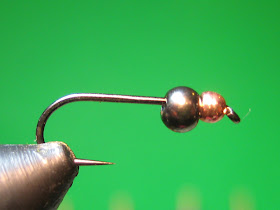Materials needed:
Hook: Any 1x long dry fly hook sizes #8-14. I am using an Allen 103BL size #14.
Thread: Tan UNI-thread 8/0.
Tail: Moose mane, or moose body hairs.
Body: Floss (olive, orange, and yellow are popular), with deer hair folded over top.
Wing: Deer hair tips from the folder over body.
Hackle: Brown.
Place your hook in the vise and start your thread near the rear of the hook shank.
Tie in your tail, 1.5 times the hook gap, or just slightly shorter than your 1x long hook shank.
Secure the butt ends to the hook shank, and wrap the butt ends forward.
Return your thread to the rear of the hook.
Measure a clump of deer hair 2x the length of the tail, and tie it in.
Measuring the deer hair is the most important step for this fly! Take your time, and start over if you made it too long.
Wrap over the flaring butts of deer hair to ensure it is secured to the hook.
Clip the butt ends as close to the hook shank as you can get without clipping your thread.
....and finish it off with some tight wraps.
It helps to keep the deer hair separated from the moose hair as much as possible. Try to keep the deer hair on the top/sides of the hook shank only.
Tie in a piece of floss, and wrap your thread forward.
Wrap your floss forward.
Don't worry about tapering the body at all since we are covering the majority of it with deer hair.
Fold the deer hair over the body, and secure it to the hook shank.
It's important that you keep the deer hair from rotating when you secure it to the hook shank. You want to make sure you can see the floss from the bottom.
At this point you can create a small thread dam in front of the wings to stand them upright.
Separate the wings with some figure-8 wraps, and then post each individual wing as you would with normal hair wing dry flies.
Tie in your brown dry fly hackle, and wrap it forward.
I use the humpy in pocket water mostly, and I like to keep them bushy so I can see them better. You can use as many wraps of hackle as you prefer.
Whip finish and trim your thread.









































